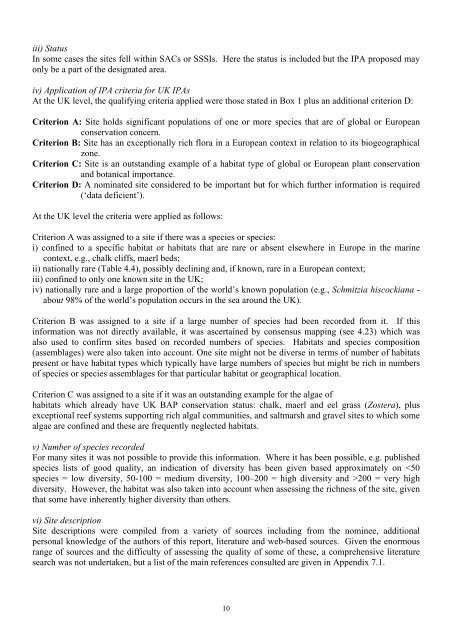Important Plant Areas for algae - Natural History Museum
Important Plant Areas for algae - Natural History Museum
Important Plant Areas for algae - Natural History Museum
Create successful ePaper yourself
Turn your PDF publications into a flip-book with our unique Google optimized e-Paper software.
iii) Status<br />
In some cases the sites fell within SACs or SSSIs. Here the status is included but the IPA proposed may<br />
only be a part of the designated area.<br />
iv) Application of IPA criteria <strong>for</strong> UK IPAs<br />
At the UK level, the qualifying criteria applied were those stated in Box 1 plus an additional criterion D:<br />
Criterion A: Site holds significant populations of one or more species that are of global or European<br />
conservation concern.<br />
Criterion B: Site has an exceptionally rich flora in a European context in relation to its biogeographical<br />
zone.<br />
Criterion C: Site is an outstanding example of a habitat type of global or European plant conservation<br />
and botanical importance.<br />
Criterion D: A nominated site considered to be important but <strong>for</strong> which further in<strong>for</strong>mation is required<br />
(‘data deficient’).<br />
At the UK level the criteria were applied as follows:<br />
Criterion A was assigned to a site if there was a species or species:<br />
i) confined to a specific habitat or habitats that are rare or absent elsewhere in Europe in the marine<br />
context, e.g., chalk cliffs, maerl beds;<br />
ii) nationally rare (Table 4.4), possibly declining and, if known, rare in a European context;<br />
iii) confined to only one known site in the UK;<br />
iv) nationally rare and a large proportion of the world’s known population (e.g., Schmitzia hiscockiana -<br />
about 98% of the world’s population occurs in the sea around the UK).<br />
Criterion B was assigned to a site if a large number of species had been recorded from it. If this<br />
in<strong>for</strong>mation was not directly available, it was ascertained by consensus mapping (see 4.23) which was<br />
also used to confirm sites based on recorded numbers of species. Habitats and species composition<br />
(assemblages) were also taken into account. One site might not be diverse in terms of number of habitats<br />
present or have habitat types which typically have large numbers of species but might be rich in numbers<br />
of species or species assemblages <strong>for</strong> that particular habitat or geographical location.<br />
Criterion C was assigned to a site if it was an outstanding example <strong>for</strong> the <strong>algae</strong> of<br />
habitats which already have UK BAP conservation status: chalk, maerl and eel grass (Zostera), plus<br />
exceptional reef systems supporting rich algal communities, and saltmarsh and gravel sites to which some<br />
<strong>algae</strong> are confined and these are frequently neglected habitats.<br />
v) Number of species recorded<br />
For many sites it was not possible to provide this in<strong>for</strong>mation. Where it has been possible, e.g. published<br />
species lists of good quality, an indication of diversity has been given based approximately on 200 = very high<br />
diversity. However, the habitat was also taken into account when assessing the richness of the site, given<br />
that some have inherently higher diversity than others.<br />
vi) Site description<br />
Site descriptions were compiled from a variety of sources including from the nominee, additional<br />
personal knowledge of the authors of this report, literature and web-based sources. Given the enormous<br />
range of sources and the difficulty of assessing the quality of some of these, a comprehensive literature<br />
search was not undertaken, but a list of the main references consulted are given in Appendix 7.1.<br />
10

















